Is there anything more frustrating than having your electric scooter die on you halfway home? The best long-range electric scooters are the marathon runners of the micro-mobility world, built with beefy batteries and smart motors designed to go the distance. They give you the freedom to explore, commute, and just ride without constantly glancing at the battery indicator.
Your Guide to Finding the Perfect Long Range E-Scooter
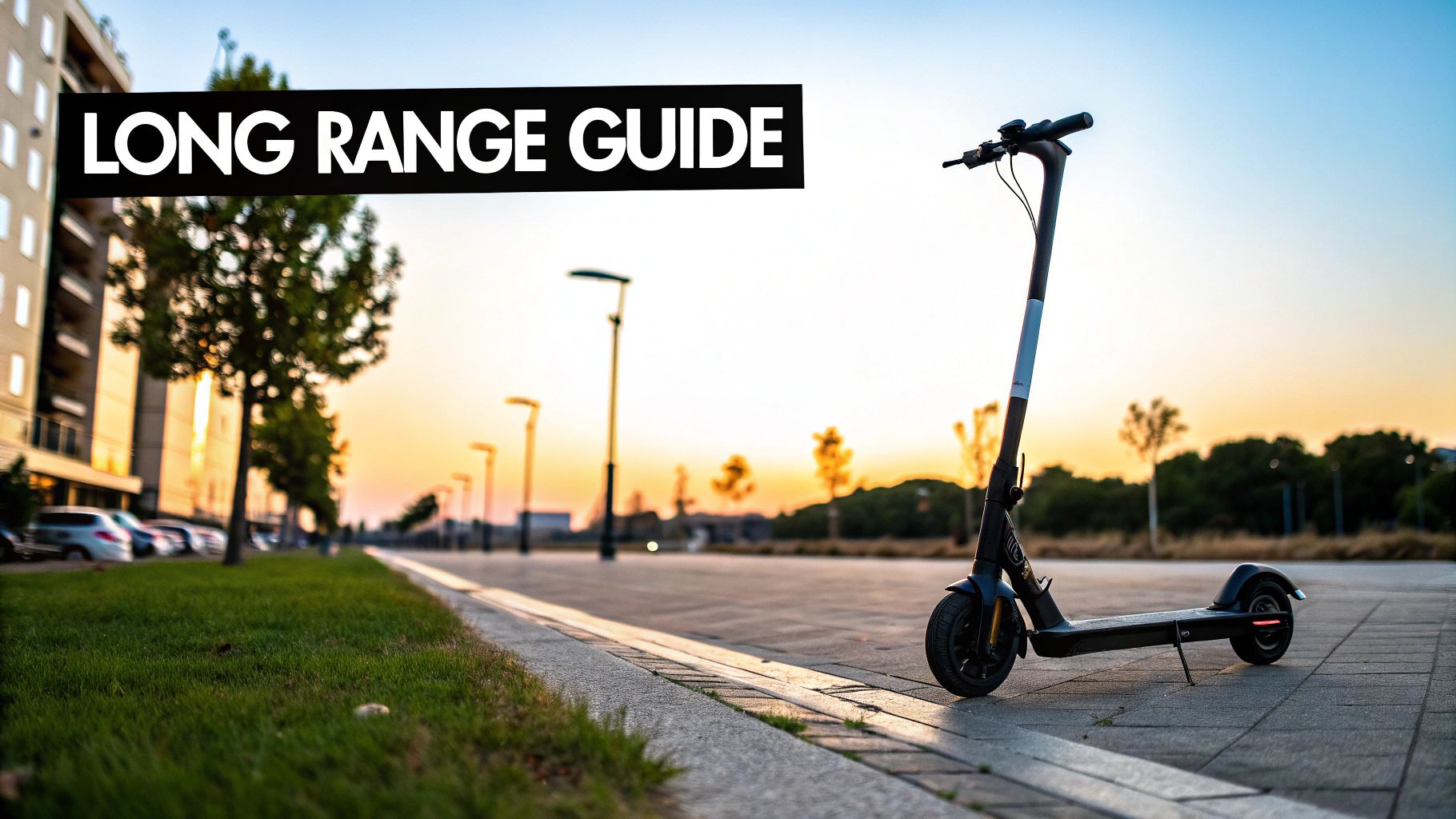
If you’re ready to finally kick range anxiety to the curb and enjoy long, uninterrupted rides, you’ve come to the right place. But picking the right scooter isn't as simple as grabbing the one with the biggest range number printed on the box. Those advertised specs are often... optimistic.
Think of it like a car's official "miles per gallon" rating. That number was achieved in a perfect lab setting, not in the real world of traffic jams, steep hills, and a heavy foot on the gas. The same goes for scooters. Your weight, the terrain, and even the temperature will affect how far you actually get on a single charge.
Our mission here is to pull back the curtain on all that marketing speak. We'll give you the real-world knowledge to pick a scooter that genuinely fits your lifestyle.
What Makes a Scooter a True Marathon Runner
The secret sauce for a true long-distance machine isn't just one thing—it’s a finely tuned combination of a few key parts. Slapping a giant battery on a scooter isn't enough; the whole system has to work together efficiently to squeeze every last mile out of the charge.
To get you started, we've put together a quick table that breaks down the must-have features of a real long-range scooter. It's a cheat sheet for what to look for.
Key Features of a True Long Range Electric Scooter
| Feature | What to Look For | Why It Matters for Range |
|---|---|---|
| Battery Capacity | High Amp-hours (Ah) or Watt-hours (Wh) | Think of this as your fuel tank. The bigger the number, the more juice you have to burn, which directly translates to more miles. |
| Motor Efficiency | Brushless Hub Motor (500W+) | A good motor turns more battery power into forward motion instead of wasting it as heat. It’s all about working smarter, not harder. |
| Tyre Type | 10-inch Pneumatic (Air-Filled) | Big, air-filled tyres roll much more smoothly than small, solid ones. Less rolling resistance means the motor doesn't have to work as hard, saving energy. |
| Build Quality | Durable Frame & Components | A well-built scooter usually means better-quality electronics inside, including the all-important Battery Management System (BMS) that keeps your battery healthy. |
This isn't just a niche hobby anymore. The demand for reliable, green transportation is exploding. The global electric scooter market is projected to hit USD 48.90 billion in 2025 and is expected to soar to around USD 321.59 billion by 2034. People are catching on.
A scooter's true value isn't a spec on a website; it's the real-world distance you can ride without constantly looking for an outlet. It's the freedom to take the long way home or go on a weekend adventure without a second thought.
This is just the starting line. To get the full picture, head over to our comprehensive electric scooter buying guide. It covers everything you need to know to make the perfect choice. Let's get you ready to ride further than ever before.
What’s Under the Hood? Understanding the Battery
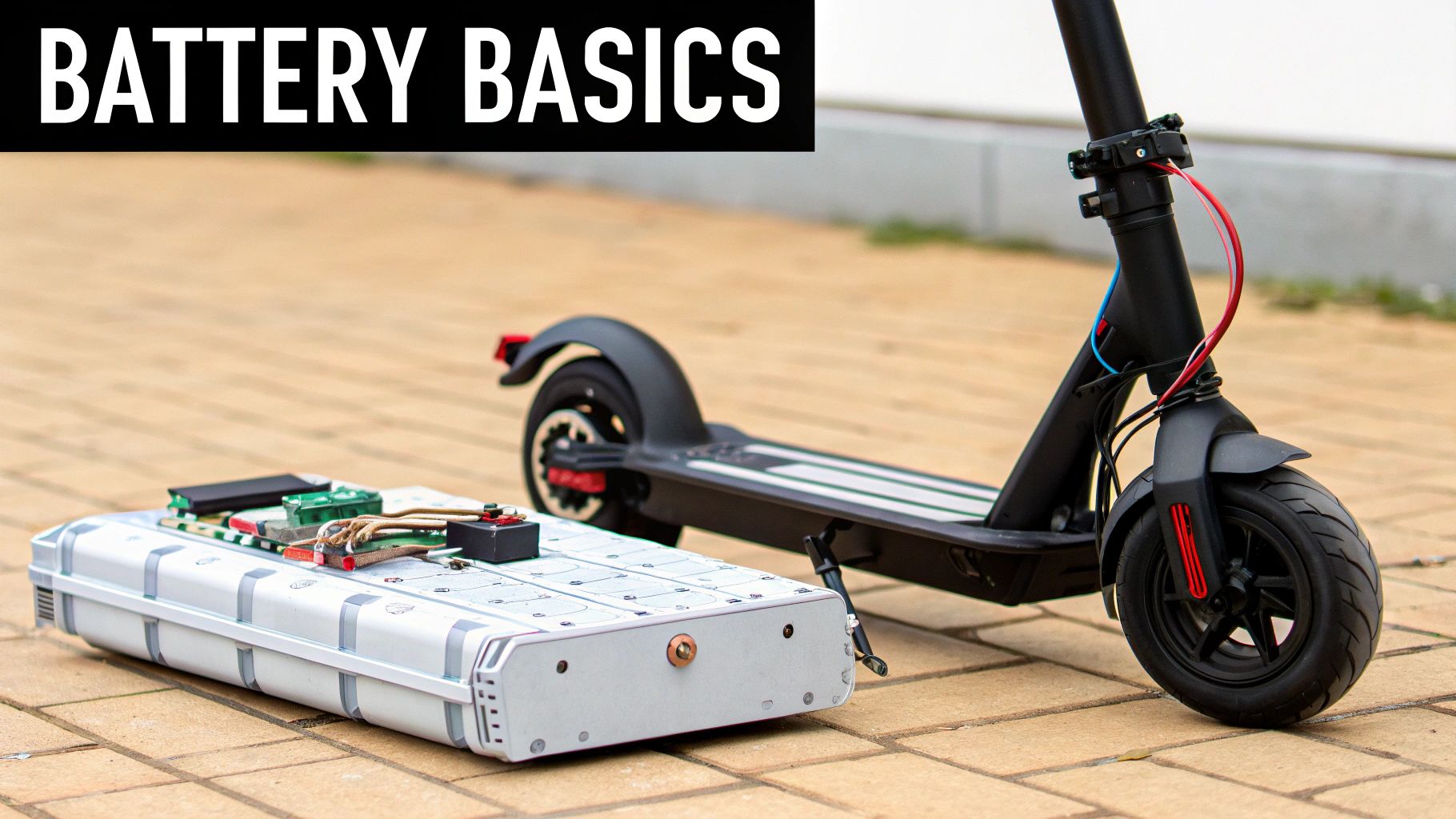
Let's get right to it. The battery is the heart and soul of any long-range electric scooter. It's the single biggest factor determining how far you can actually go on a single charge.
Think of it like the gas tank in a car. A bigger tank gets you more miles, and it’s the exact same idea here. Once you know what to look for on a spec sheet, you can instantly tell if a scooter is built for a quick trip to the store or a genuine long-haul adventure.
Imagine you're gearing up for a serious hike. The amount of water you can carry is limited by the size of your water bottle. For electric scooters, this is called battery capacity, and it’s measured in Amp-hours (Ah) or Watt-hours (Wh). The higher the number, the bigger your "water bottle"—and the more juice you have for the journey.
But that's only half the picture. The other crucial number is Voltage (V). If capacity is how much water you have, voltage is the pressure pushing it out. High pressure helps you tackle tough jobs, like blasting grime off a patio. For a scooter, higher voltage means more raw power and torque to conquer steep hills and get up to speed quickly.
The best long range electric scooters nail this balance, pairing a high-capacity battery with enough voltage to deliver a ride that's both powerful and long-lasting.
Why Lithium-Ion Is the Gold Standard
As you shop around, you'll see one name pop up over and over: Lithium-ion. There’s a very good reason it’s the industry king. These batteries have incredible energy density—a technical way of saying they cram the most possible power into the lightest, most compact package. This is what allows manufacturers to give us scooters with incredible range without them weighing a ton.
The market has spoken, and lithium-ion is the clear winner. It powers 85% of all electric scooters for a simple reason: it delivers far more range and performance than any of the older, clunkier battery types. Most top-tier long-range models have settled into a sweet spot between 25V and 50V, which gives them that perfect blend of punch and endurance.
The real magic of a great battery isn't just its size; it's how intelligently its power is managed. A high-capacity battery without a smart "brain" is like a powerful engine with a faulty computer—inefficient and prone to problems.
The Unsung Hero: The Battery Management System
That little "brain" is called the Battery Management System (BMS). It's a small but vital circuit board that acts as your battery's personal bodyguard, health coach, and traffic cop all rolled into one. You’ll never see it, but it’s working nonstop to keep everything running smoothly and safely.
The BMS handles a bunch of critical jobs:
- Prevents Overcharging: It cuts off the power when your battery is full, which is essential for preventing damage and maintaining its health.
- Stops Over-Discharging: It also prevents the battery from draining to absolute zero, which can permanently kill the cells and shorten its lifespan.
- Keeps Cells Balanced: A scooter battery is actually a pack of many smaller cells. The BMS makes sure they all charge and discharge at the same rate, which is key to consistent performance.
- Monitors Temperature: It's constantly checking the battery's temperature, ready to shut things down if it gets dangerously hot or cold.
A quality BMS is absolutely non-negotiable in the best long range electric scooters. It’s what protects your investment and ensures you get reliable power ride after ride, year after year. To get more out of your power pack, check out our guide on maximizing your electric bike battery life—the same principles apply
How Motors and Efficiency Affect Your Real-World Range
If the battery is the heart of a long-range scooter, the motor is the muscle. It’s the part that turns all that stored electrical energy into the get-up-and-go that makes riding so much fun. But when you’re hunting for a scooter that can really go the distance, just grabbing the one with the biggest motor isn't always the right move.
Think of it like a car engine. A beastly V8 is a blast to drive, but it drinks fuel like there’s no tomorrow. A smaller, more modern engine might not win you any drag races, but it’ll get you a whole lot further on a single tank. It’s the exact same principle with electric scooter motors.
It really comes down to a trade-off between raw power and smart efficiency. A scooter built for pure speed will often have a power-hungry motor that chews through the battery in no time. The ones built for endurance, however, tend to have moderately powered, super-efficient motors that just sip at the battery, letting you cruise for miles.
Nominal Power vs. Peak Power
As you browse scooter specs, you'll see two different power ratings for the motor, both measured in Watts (W). It can seem a bit technical, but it’s actually pretty straightforward.
- Nominal Power: This is the motor's everyday, continuous power. It’s the steady output it can comfortably deliver without getting too hot on a regular ride. Think of it as your cruising speed on a long, flat road.
- Peak Power: This is the short burst of maximum power the motor can kick out when you need it most. It's that extra juice for accelerating fast from a standstill or powering up a steep hill. It’s like a sprinter finding that last burst of energy for the finish line.
For true long-range riding, a healthy nominal power rating (look for 500W or more) is what really counts. This tells you the motor can handle the daily grind without straining itself, which is crucial for maintaining efficiency over a long journey. High peak power is fun, but it's the nominal rating that really speaks to a scooter's staying power.
An efficient motor is like a seasoned marathon runner, pacing themselves and conserving energy for the entire race. A powerful but inefficient motor is more like a sprinter who goes flat-out from the start and gasses out halfway through.
Regenerative Braking: The Secret Range Booster
So, how do the best long-range scooters squeeze every last bit of power from their batteries? One of the cleverest features you'll find is regenerative braking. It's a brilliant bit of tech that essentially turns your motor into a mini-generator every time you slow down.
Here’s how it works: when you pull the brake or just ease off the throttle, the system reverses the motor's job. Instead of using battery power to turn the wheels, the forward momentum of the wheels actually spins the motor. This process generates a small amount of electricity, which gets fed right back into the battery.
Now, it’s not going to fully recharge your scooter on the go. But during a long ride with plenty of slowing down and stopping—like a typical city commute—all those little bits of recycled energy really start to add up. It might just give you that extra mile or two you need to get home, which could be the difference between a smooth ride and an awkward walk.
This kind of smart tech is a true sign of a well-designed scooter, where every watt of power is put to good use. If you want to see how different models and their features stack up, you can easily compare electric scooter specifications in our detailed guide.
Decoding Advertised Range vs. Real-World Performance
So you've found a scooter with a beast of a battery, and the box promises an incredible 50-mile range. Awesome! But then, after a few rides, you realize you're lucky to get 35 miles. What gives?
Welcome to the classic gap between advertised specs and what you actually get on the road.
That impressive number on the marketing material wasn't a lie, but it was achieved under perfect, almost sterile lab conditions. Picture a super-light rider on a perfectly smooth, flat track with zero wind, cruising at a steady, battery-sipping speed. Your daily commute through bumpy city streets, complete with hills and traffic, is a completely different world.
Knowing what factors chew through your range is the key to choosing one of the best long range electric scooters with enough juice in the tank to handle your life, not just a lab test.
The Real-World Range Killers
Every little part of your ride costs energy. From the weight you’re carrying to the air you’re pushing through, your scooter’s battery is in a constant battle against forces trying to slow it down. The harder it has to fight, the faster that battery gauge plummets.
Let's break down the biggest culprits that will drain your battery far quicker than you’d expect.
-
Rider Weight: This is the big one. A scooter's motor has to work way harder to haul a 95kg rider up a hill than a 70kg one. Heavier riders will always see a noticeable drop in max range, often by 20-30% or more compared to the sticker number.
-
Hilly Terrain: Climbing hills is the single most power-hungry thing your scooter does. Every single incline forces the motor to draw maximum power from the battery, draining it in a hurry. A route with constant ups and downs will slash your range compared to a nice, flat one.
-
Stop-and-Go Riding: Think about it—constantly accelerating from a dead stop takes a huge burst of energy. Riding through a busy city centre with tons of traffic lights and junctions is way less efficient than maintaining a steady speed on an open bike path.
This data chart shows the delicate balance between a motor's power, how efficiently it uses that power, and the range you can realistically expect.
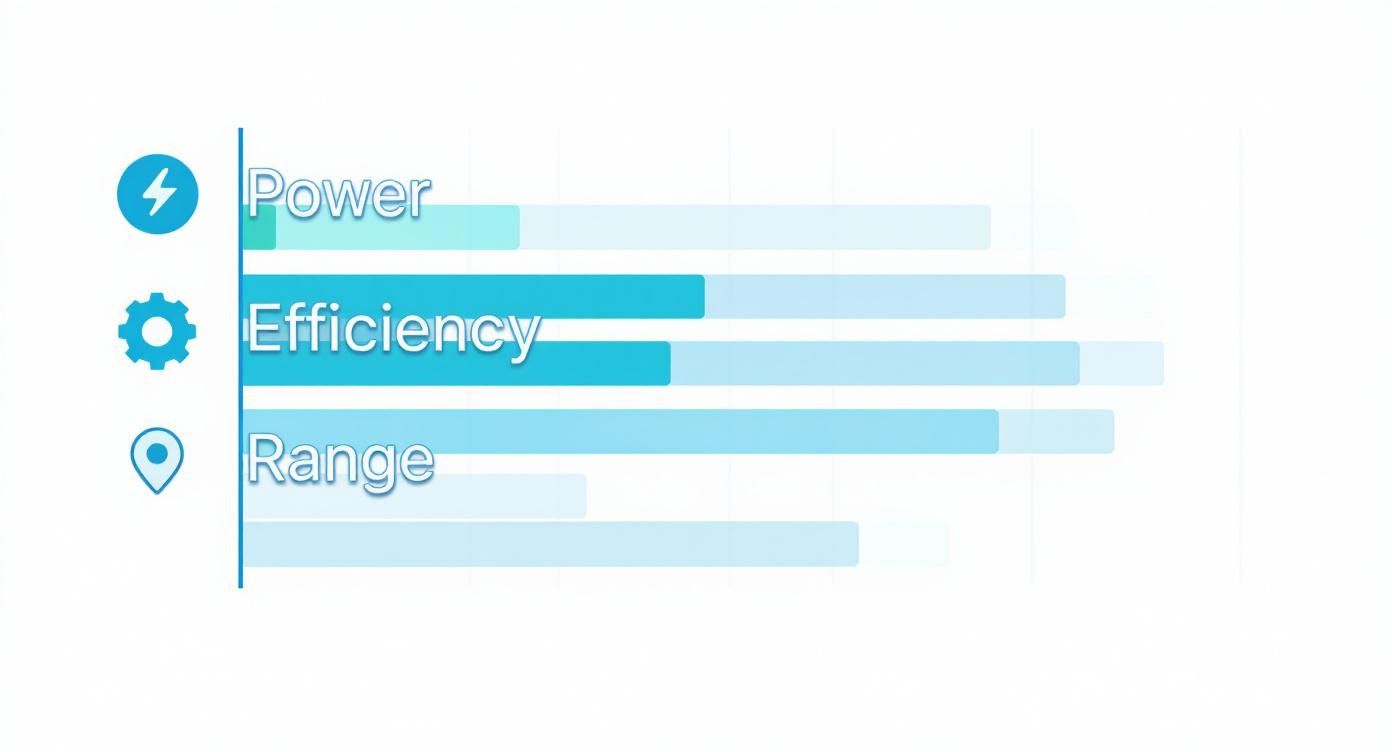
As you can see, the longest range doesn’t just come from raw power; it comes from a motor that sips that power smartly.
The Little Things That Add Up
On top of the big three, a bunch of smaller factors can quietly eat away at your battery life. Each one might seem minor, but their combined effect can easily steal a few miles from your trip.
I like to think of these as "energy leaks"—small, constant drains that add up. Just like a dripping tap wastes water, these things waste precious battery power.
Here’s a quick rundown of the most common variables and the kind of hit your range can take.
Common Factors That Reduce Your E-Scooter's Range
| Factor | How It Affects Range | Estimated Range Reduction |
|---|---|---|
| Rider Weight | Heavier loads require more motor power to accelerate and maintain speed. | 10% - 30%+ |
| Hilly Terrain | Climbing hills is extremely energy-intensive, drawing maximum current. | 20% - 50% |
| Aggressive Riding | Frequent, hard acceleration uses significantly more power than smooth cruising. | 15% - 40% |
| Cold Weather | Low temperatures reduce a battery's efficiency and total capacity. | 10% - 25% |
| Low Tyre Pressure | Under-inflated tyres increase rolling resistance, making the motor work harder. | 5% - 15% |
| Headwind | Fighting wind resistance is like riding constantly uphill. | 5% - 20% |
These numbers are just estimates, of course, but they show how quickly all these little things can stack up against you.
Your real-world range is a moving target that changes every day based on your route, the weather, and how you ride. The trick is to buy a scooter with enough extra range so that even on your worst day, you still have more than enough to get home.
A few more things to keep in mind:
-
Tyre Pressure: Seriously, keep your tyres properly inflated. Under-inflated tyres create more friction with the ground, and it's one of the easiest ways to instantly boost your efficiency.
-
Cold Weather: Batteries just don't like the cold. In near-freezing temperatures, a lithium-ion battery’s performance dips, which can temporarily knock its range down by as much as 20%.
-
Wind Resistance: Ever tried riding into a strong headwind? It feels like you're going uphill, and that’s exactly what it feels like for your motor, too. It has to use extra power just to push through the air.
Once you get a handle on these variables, you can figure out the range you actually need and find a scooter that delivers it, day in and day out.
A Practical Checklist for Choosing Your Scooter
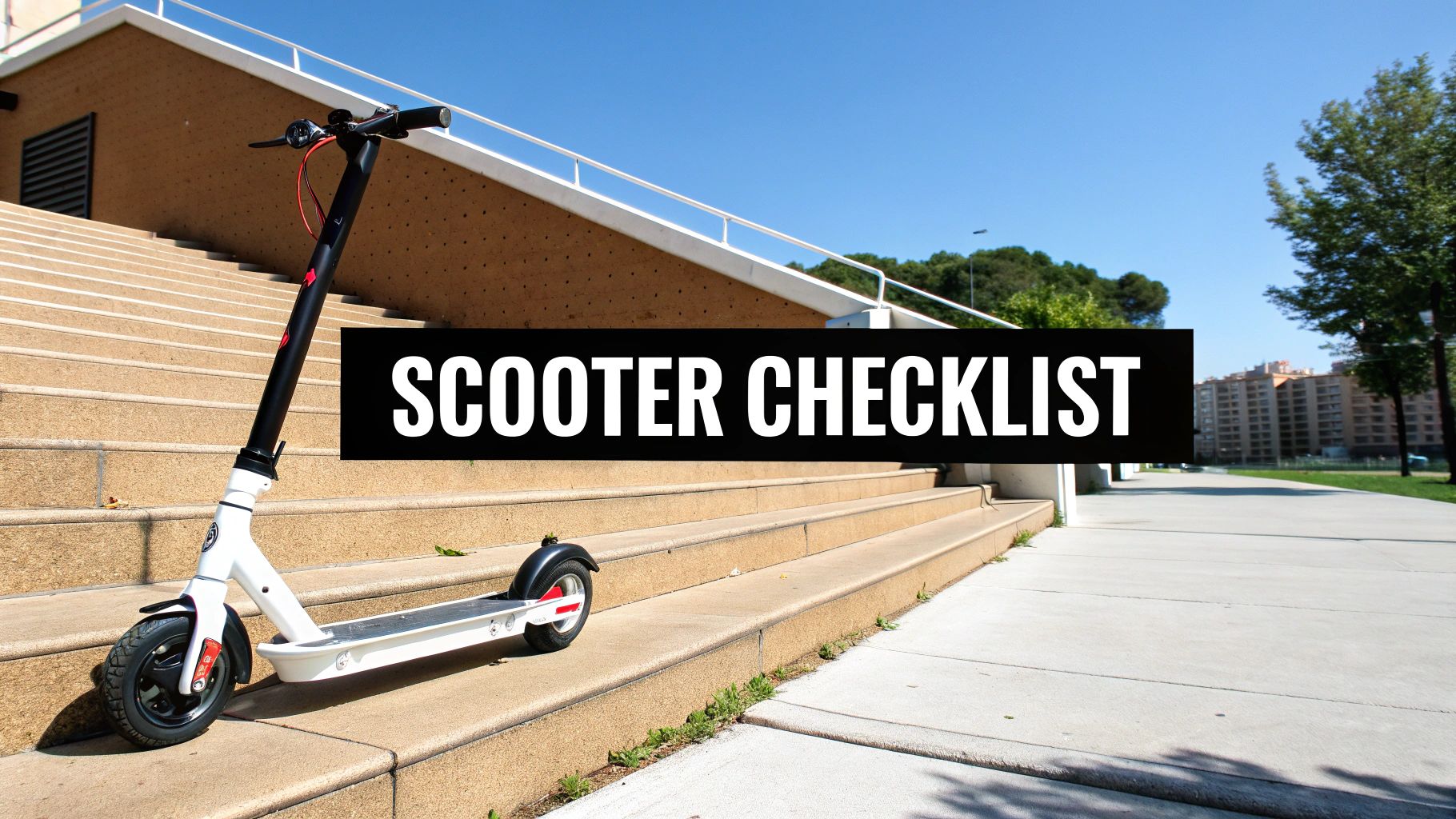
Okay, so you’ve got the lowdown on batteries, motors, and what "real-world range" actually means. Now for the fun part: putting it all together to pick your perfect ride. Having a scooter that can go for miles is one thing, but it’s completely useless if it’s a pain to live with day-to-day.
This is where the rubber meets the road, so to speak. You have to balance the dream of a marathon machine with the practical realities of your life. A scooter with a monster battery sounds incredible on paper, but are you really prepared to lug a beast of a machine up three flights of stairs to your flat? It’s time to think about the whole package.
Balancing Range with Portability
The first big compromise you'll run into is range vs. weight. They’re two sides of the same coin—a bigger battery almost always means a heavier scooter. For some people, that’s no big deal. If you've got a garage with easy access, a heavier, more solid scooter could be exactly what you need.
But if your daily routine involves hopping on a train, carrying it into the office, or hauling it up to your apartment, portability suddenly becomes a huge deal. A scooter tipping the scales at over 20kg (44 lbs) goes from being a convenience to a dead weight, fast. Be brutally honest with yourself about how much lifting you're actually willing to do.
The best long-range electric scooter for you is one that slots into your daily routine, not one that turns your commute into an unwanted gym session.
Really think about these points:
- Where you live: Got stairs? Is there a safe, ground-floor spot to store and charge it?
- Your commute: Will you have to carry it on public transport? Does your office have a lift or a decent place to park it?
- Your own strength: A scooter's weight on a spec sheet feels a lot different when you're wrestling it up a crowded staircase.
Ride Quality for Real-World Streets
Let’s be real, a scooter’s massive range is pointless if the ride is so teeth-chatteringly awful that you dread getting on it. The comfort of your journey, especially on the often-dodgy pavements of US and Australian cities, really comes down to two things: suspension and tyres.
Think of suspension as the scooter’s knees, absorbing all the nasty jolts from potholes and cracks before they rattle your skeleton. If you're going to be a daily rider, a model with dual suspension (one at the front, one at the back) will make a world of difference, giving you a much smoother and more pleasant ride.
Tyres are just as crucial. Those small, solid rubber tyres are great because they can't get a puncture, but you’ll feel every single bump in the road. For the best ride quality, you really want to look for 10-inch pneumatic (air-filled) tyres. They act like a natural cushion, soaking up small bumps and giving you way better grip, which is a massive confidence booster.
Build Quality and Essential Safety Features
When you're depending on a scooter every day, you need to know it's built to last. Keep an eye out for scooters with a solid-feeling frame, neat cables, and a folding mechanism that locks securely into place. A wobbly handlebar stem or a creaky deck are major red flags that the manufacturer has cut corners.
Just as important—if not more so—are the brakes. Stopping power is simply not something you can compromise on.
- Disc Brakes: These are the best of the best. They provide fantastic, reliable stopping power in both wet and dry weather, making them the top choice for safety.
- Drum Brakes: Tucked away inside the wheel hub, drum brakes are low-maintenance and protected from grime. They offer good, consistent braking performance.
- Electric Brakes: These often work alongside a physical brake, using the motor to slow you down. They can even send a tiny bit of energy back to the battery (that’s "regenerative braking"). They're great as a backup but don't have the urgent stopping power you need in an emergency.
Finally, always check the IP (Ingress Protection) rating. For anyone riding in various climates, a rating of at least IPX4 is a must. This means the scooter can handle splashes from any direction, so you don't have to panic if you get caught in an unexpected shower. A higher rating like IPX5 or IPX6 is even better. It’s a small detail, but it makes a huge difference for a dependable, all-weather commuter.
What's Happening in the World of Long Range Scooters?
The search for the perfect long-range electric scooter isn't just happening in your neighborhood—it's a global phenomenon. But what a rider needs in Los Angeles is a world away from what someone in London or Sydney is looking for. Every region has its own vibe, shaped by everything from local laws and city layouts to the weather.
In the United States, there is a massive demand for more powerful, high-performance scooters. Regulations are a patchwork, varying from state to state and even city to city. These aren't just for a quick trip to the store; they're built for long suburban rides, where you need speed and enough muscle to tackle serious hills.
Jump across the pond to the UK and Europe, and you'll find a different scene. Riders there need scooters that can go the distance but are also legal to ride on public roads, often as part of government trials. This means there's a huge focus on safety features like top-notch brakes and solid water resistance for those famously drizzly commutes.
How Different Cities Shape Scooter Design
Down under in Australia, riders want a mix of toughness and performance that fits their outdoor-centric lifestyle. They need scooters that can handle anything from smooth bike paths to slightly rougher terrain, all while baking in the intense sun. For them, build quality and a battery that won’t quit in the heat are deal-breakers.
You can't talk about regional differences without mentioning government policy. In the US, the explosion of scooter-sharing services has been a gateway for millions of people, getting them hooked on micro-mobility and driving up sales of privately owned models. The ongoing e-scooter trials in the UK, for example, are pushing manufacturers to double down on safety and compliance.
The best long-range scooter is a direct reflection of its environment. It’s a machine built not just for distance, but for the specific challenges and expectations of its home turf—whether that’s navigating a sun-drenched coastal path or cruising through wet city streets.
Market Growth and What It Means for You
This worldwide buzz translates into some serious growth. The scooter market is expanding everywhere, but each region is growing in its own unique way. Take the United States, where the scooter market is expected to pull in USD 165.35 million in revenue by 2025. The scooter-sharing slice of that pie alone is set to grow by a whopping 15.0% (CAGR).
Europe is right there with them. The UK's e-scooter scene is taking off, thanks to government support and a real shift in how people get around cities. You can dig into more of these market trends over at Statista.com.
So, what’s the big takeaway from all this? Manufacturers are finally getting the message that "one-size-fits-all" is a dead end. They're now designing scooters with specific regions in mind, which is fantastic news for us. It means you've got a better shot than ever at finding a long-range scooter that feels like it was built just for you and your city.
Got Questions About Long Range E-Scooters?
Alright, even after digging into all the specs, you probably still have a few nagging questions. It’s totally normal. Let's tackle some of the most common ones I hear from riders so you can choose the right scooter and ride it with total confidence.
How Can I Squeeze More Miles Out of My Battery?
Getting the most juice out of your battery is part art, part science. It’s not just about how you ride, but also how you treat it. Think of it like taking care of a high-performance engine—a little TLC goes a seriously long way.
First off, keep your tires properly inflated. Soft tires create a ton of drag and just gobble up energy. Ride smoothly, too. Those aggressive, jerky starts might feel fun, but they absolutely drain your battery. Finally, don't let your scooter sit for weeks on end with a completely dead or 100% full battery.
Here's a pro tip: for daily riding, try to keep your battery between 20% and 80%. This simple habit takes a lot of stress off the battery cells and can seriously extend its lifespan. You'll thank yourself for it down the road.
Does My Weight Really Affect the Range?
Oh, absolutely. It's probably the single most overlooked factor when people are shopping for a scooter. Think about it: most brands test their range with a rider who weighs around 70-75kg (154-165 lbs), riding on a perfectly flat surface.
If you weigh more than that, the motor simply has to work harder to move you, especially up hills. A heavier rider might see their real-world range drop by 20-30% (or even more) compared to what's advertised on the box.
So, when you're choosing, be honest about it. Don't just pick a scooter that barely meets your daily commute distance. Give yourself a generous buffer to account for your weight, hills, and wind.
Ready to conquer your commute without constantly checking the battery meter? At Punk Ride LLC, we’ve hand-picked a lineup of the best electric scooters built for real-world distance. Explore our collection and find your perfect long-range ride today at Punk Ride.




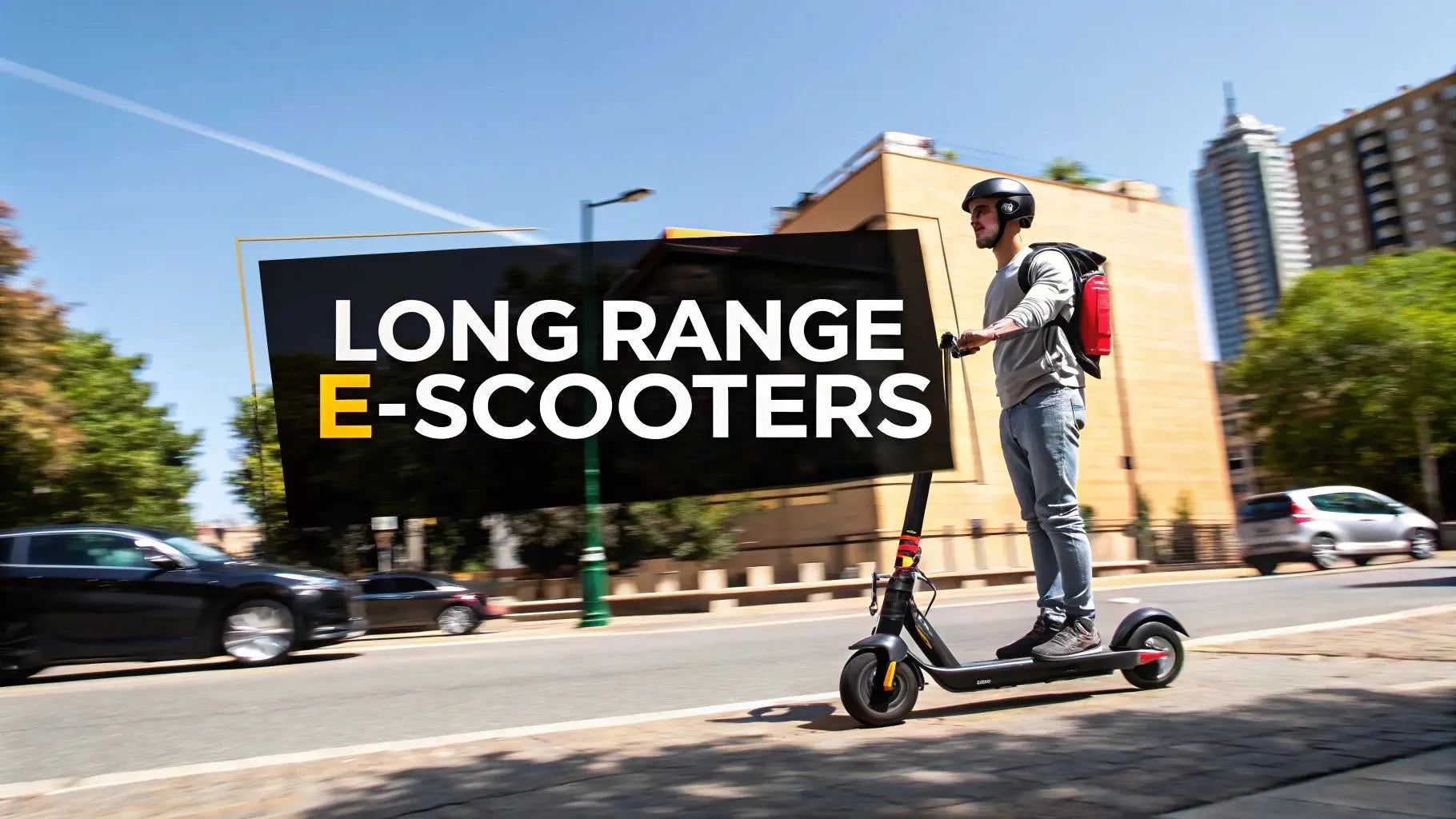
Share:
Best lock for electric bike: Choose the right security
Electric Bike vs Scooter for Commuting: A Practical Guide